Posts Tagged ‘graphic novels’
The recommendations in this post also appear on my Brave Writer Retreat Resources page, which includes books and materials mentioned in my other talks at the Retreat (Tidal Homeschooling and Read-Alouds).
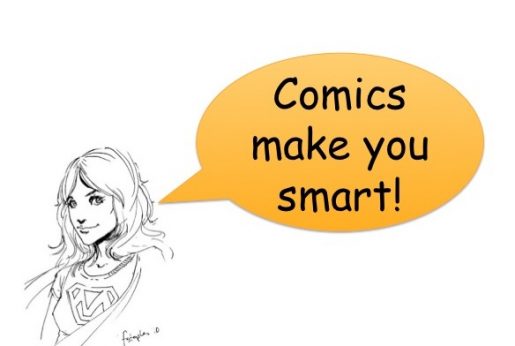
The following comics and graphic novels are recommendations from my “Comics Make You Smart” talk, presented at the Brave Writer Retreat in July, 2016.
Part of this talk was broadcast on Periscope—you can view it here. Note: For now, what follows is simply a booklist—no mini-reviews. I’ll add those as time permits. I promised the retreat attendees I’d put together a post of all the comics I mentioned in my talk, so here it is for easy reference. Commentary to come later!











Gotham Adventures by Scott Peterson (my brilliant hubby)—Batman comics aimed at young readers. These came out monthly in the ’90s and are now available in digital editions. (The books at this link that say “by Ty Templeton” were edited by Scott; the others were written by him.)
(more…)
August 28, 2013 @ 7:34 pm | Filed under:
Books 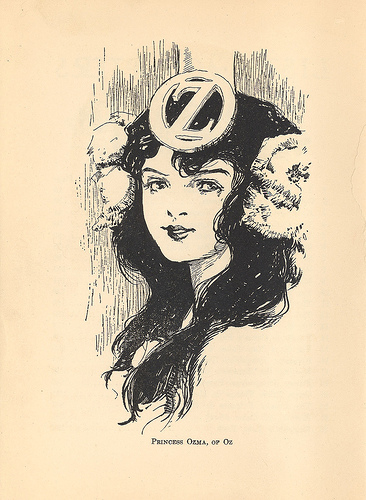
Illustration by John R. Neill
I loved the Oz books as a kid. Loooooved them. Collected the whole series, the Baum-authored ones plus a couple of the Ruth Plumly Thompson sequels, and enlisted my father’s help to track down the Very Best Editions, the white-bordered oversized trade paperbacks with John R. Neill illustrations.
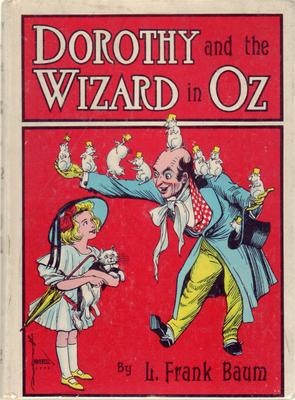
I reread the entire series regularly all through high school and even on college vacations. Dorothy, Ozma, Tik-Tok, Scraps, the Hungry Tiger, the Glass Cat, Betsy Bobbin, Billina, Polychrome, General Jinjur, the Shaggy Man, Button-Bright: this astonishing array of lively characters peopled my imagination and taught me a great deal about diversity, varying points of view, and fun. They were an outspoken bunch, these Oz folks. They had strong opinions; their perspectives clashed; they worked through conflicts and celebrated one another’s quirks. I adored them. Still do.
Strangely, the Oz books never seemed to take off for my kids as read-alouds. Baum’s prose is, I confess, a bit arch, sometimes saccharine. His genius was for character and plot, not lyricism. My older three girls went through waves of reading the series on their own, but they didn’t seem to catch Oz fever with the intensity I had.
Enter Rilla. Well, first enter Eric Shanower and Skottie Young, who are bringing the Oz books to a new generation of readers via truly gorgeous graphic novel adaptations published by Marvel. Oz, overflowing as it is with colorful, outlandish characters, was made for graphic depictions. Eric Shanower (who has become a friend of mine through Comic-Con and SCBWI) is a true Ozian—why, his own press is called Hungry Tiger, and his contributions to Oz literature and fandom are staggering. His adaptations are faithful, deft, and affectionate. And Skottie Young’s art, while a departure from the John R. Neill images burned into my brain as canon, is wholly delightful. It’s clear he is having tremendous fun bringing these creatures to life.
I’ve mentioned before that Rilla, as a reader, is drawn to books with a heavy illustration-to-text ratio. She prefers Brambly Hedge to Little House, for example; those gorgeous, intricately detailed drawing of tree-stump pantries and attics can occupy her for a full afternoon. She’ll spend an hour talking to me about Eric Carle’s techniques. For her, art is the magic; an accompanying plotline is simply a nice bonus.
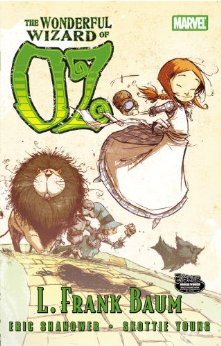
We brought Eric and Skottie’s The Wonderful Wizard of Oz home from SDCC last month, and Rilla—well, you’d have thought we gave her an actual trip to the Land of Oz, she was so excited. It’s the longest, hardest book she has read on her own. Oh yes, it’s a graphic novel, but the text is quite sophisticated: there’s some nice meaty vocabulary in the dialogue. Baum didn’t talk down to his young readers, and neither does Eric Shanower. (And of course I’ve written volumes before about the excellent reading skills imparted by comics: there’s a lot of complex decoding going on as a young reader navigates those panels.)
“Bad news,” she told me mournfully one day. “I finished the best book in the world.”
“Guess what,” I whispered. “There are more.”
Her gasp, her shining eyes: no Princess of Oz was more radiant.
The next week’s worth of bedtimes saw her poring over The Marvelous Land of Oz, one of my favorite books in the series (both the original and the graphic adaptation). Every morning, she narrated the previous night’s events to me, dancing with suspense as the story unfolded, and belly-laughing over the ending.

Then came Ozma of Oz, a book for which my deep affection renders me nearly incoherent. Even that sentence is on shaky grammatical territory. Imagine a lot of squealing noises and some Rilla-esque bouncing around. I mean, I mean, Tik-Tok and the Wheelers! The lunch-pail trees! The loathsome, fabulous Princess Langwidere and her collection of interchangeable heads. SHE WANTS DOROTHY’S HEAD FOR THE COLLECTION, YOU GUYS. Come on. And then the Nome King and his high-stakes guessing game (shades of Heckedy Peg), and Billina the Hen’s surprising trump card. Oh, oh, oh.
Don’t tell Rilla, but I’d already given a copy of Ozma to my goddaughter, Vivi, whose mother is, if anything, an even bigger Oz fanatic than I am. She even looks like Ozma. (Krissy, why why why didn’t we ever go as Ozma and Polychrome for Halloween?)
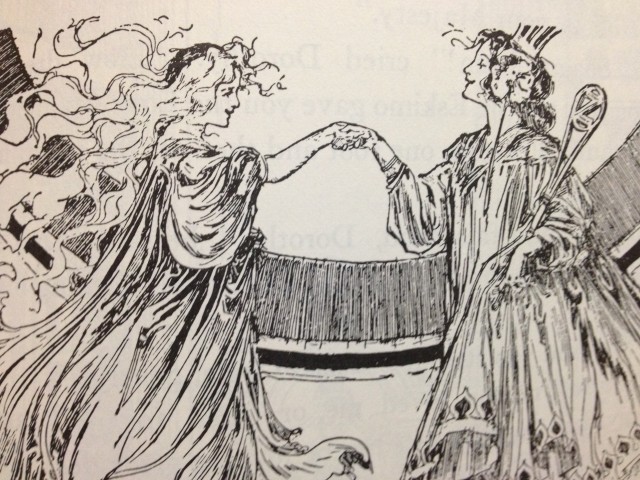
Polychrome, the Rainbow’s Daughter, meets Princess Ozma. Illustration by John R. Neill.
Rilla hasn’t met Polychrome yet. She will swoon, mark my words. The Rainbow’s Daughter? Polly of the swirling robes and floaty hair? Rilla’s a goner. Like Ozma, she’ll make Polly’s acquaintance in The Road to Oz. I can’t wait to see what Skottie Young does with Polychrome and the Shaggy Man. Both characters are bubbling over with the whimsy he captures so well.
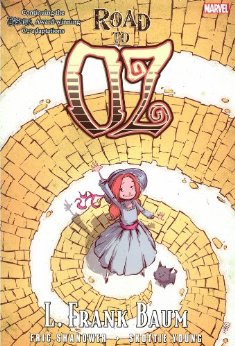
But first comes Dorothy and the Wizard in Oz. Even for Baum, this is a bizarre tale. Dorothy gets caught in a San Francisco earthquake and falls all the way to the center of the earth, where weird vegetable people (as in, they grow on vines) called the Mangaboos are on the verge of executing her when, whew!, who should float down in his balloon but Dorothy’s old acquaintance, the Wizard?
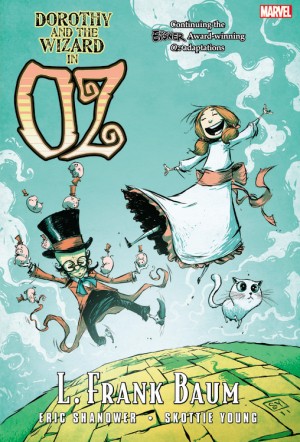
After that comes The Emerald City of Oz. Rilla and I may not be able to wait for the collected edition; we might have to start picking up the floppies from our local comic shop.
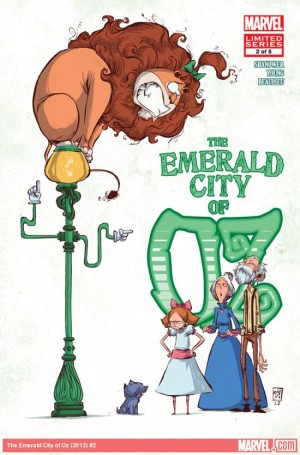
I was supposed to go to L.A. today to do something really super-fun, but I came down with a nasty cold instead. Because I am spontaneous and exciting like that. I’ve spent the weekend sprawled against my pillows in tragic poses (when someone is looking) and devouring Cybils nominees (when no one’s watching).


Last night, around ten, I finished Brian Selzick’s breathtaking Wonderstruck, bawling through the last forty pages. Which is the highest praise I can give a book: “it moved me deeply.” Now, I don’t know how people are writing reviews of this book without spoiling all its surprises, so I’m not going to say anything specific about it at all. Yet. Read it, and then let’s have a nice long chat about it, okay?
Picture books Rilla enjoyed this week:
Chicken in drawing decides to help with the painting; hijinks ensue. Delicious art. This would be lots of fun to pair up with other picture books that break the fourth wall, such as David Wiesner’s The Three Pigs or Melanie Watt’s Chester.
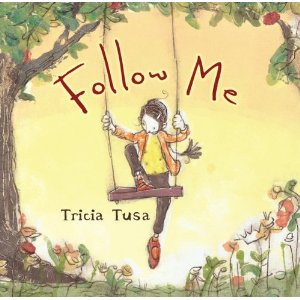
Lyrical poem with perfectly lovely art (I’d like walls the colors of her skies). “This book was very…unusual,” declared Rilla approvingly. I think what she meant was that it’s non-narrative, not plot-driven. Girl on swing thinking soaring thoughts.
More book recommendations here.
December already! Impossible.
I’ve been trying to catch up my GoodReads log, but with all these graphic novels I’m reading for Cybils, it’s hard to keep it up to date. November’s list is too long to recreate here, but I’ll call out a few of my favorite reads from the month.
(Links go to GoodReads.)
I keep calling this Trollville by accident because of the (perfectly delicious) subtitle: “Yet another troll-fighting 11-year-old Orthodox Jewish girl.” Middle-grade graphic novel published by Amulet Books. Enchanted Beanie and me. Mirka wants to fight monsters but gets entangled with a foul-tempered talking pig instead. Her sometimes comical, often hair-raising adventures occur in the context of a full, tradition-centered home life. I love books that mingle the small, gritty challenges of daily life with grand, fantastic adventures—but maybe you already knew that about me?
This is the gift to give your 8-12-year-old nephew or niece if you want the Coolest Uncle Ever award. Or Coolest Aunt. Whichever. An aging superhero announces that he is holding auditions for a new sidekick. His pets, who miss his company, decide to try out. His pets? Are a dog, a hamster, and a lizard. That’s right. The hamster is trying out for the superhero sidekick gig. It’s equal parts heartwarming and hilarious. And the art just knocked—my—socks—off.
This book is really special. It’s a memoir in words and pictures. Allen Say recounts the story of his life with poignant candor. At age twelve, he goes to Tokyo to live alone (!) in order to attend a good school. His tiny one-room apartment has everything young Allen needs: solitude and a desk he can draw at. In a move full of gumption, he approaches a renowned cartoonist and asks to train under him. Amazing story. Beanie’s read it at least three times now.
I read some other excellent books this month and maybe I’ll do a part two of this post, but the days do roll away from me.
The other day I was sharing some thoughts on Twitter about storytelling and layout problems I see in many (but by no means ALL) of the graphic novels coming out of book publishing houses lately, and Raina Telgemeier (Smile) chimed in with a link to an essay that had a profound affect on her development as an artist. Here’s our conversation, with the essay link at the bottom. The essay is called “How to Read Nancy” by Mark Newgarden and Paul Karasik, and it’s fascinating. The authors take a close, critical look at the old Nancy comic strip by Ernie Bushmiller. Yes, really! It’s some of the best analysis of visual design principles I’ve ever read.
Me:
Dear book publishers branching into graphic novels: Thrilled, but your ballooning & storytelling mistakes are KILLING me.
@ryancecil asked:
Wouldn’t that be the author/artist’s mistake first?
Me:
Yes but it’s the editor’s job to hire good pencillers, correct clumsy storytelling.
First Second, Random House, Scholastic are doing graphic novels well. Sometimes lettering/ballooning could be better but hey, so could Big 2’s [Marvel & DC]
I’m talking about readability here, not plot. Visual storytelling, ballooning, lettering. Layouts, camera angles, the way a page flows.
Am seeing books from other publishers which make what seem to me rookie mistakes. Confusing layouts & ballooning, stacking panels on left, etc.
Raina:
Just reading your thoughts on GNs. I agree, confusing balloon/panel layout is a real problem! Especially for kids’ books.
Me:
Yes, in kids’ graphic novels, good ballooning/layout even more important. Should lead eye, not perplex. YOUR layouts rock, btw!
Have read several dozen kids’/YA graphic novels for Cybils this month, dozens to go by end of year. At least 1/2 make panel layout mistakes.
I think many GN artists are following film storytelling technique rather than good comics technique. Also too much fancy lettering.
I’m seeing some stellar graphic novels this year, mind you. Some that make you feel lucky to be alive & reading in 2011.
Raina:
When I’m laying out pages, I start with the panels/boxes. Lettering & balloons come next—before the drawings!
Mark Newgarden wrote a terrific article called How To Read Nancy with the bare bones of comics principles… http://t.co/rflMWCFF [link opens a PDF]
I read it as a teenager and have applied the logic to my work ever since.
Specifically, how to lead the reader’s eye thru a comic, to arrive at the punchline/end of the page exactly as artist intends.
This explains a lot about why Raina’s work is so terrific.
(I am champing at the bit for her upcoming middle-grade graphic novel, Drama, about a school drama club, aka MY PEOPLE.)
Enjoy the “Nancy” essay.
P.S. Raina is the only other person I know whose husband proposed to her in a comic book. Read it and melt. 🙂
A friend pointed me toward a conversation in which a 6th-grade teacher explains why he “reflexively cringe[s]” when he sees his students head for the comics and graphic novel section of the school library. His first post, which suggests that graphic novels are “nothing more than the literary equivalent of Jersey Shore for our kids,” drew an impassioned response from comics advocates. (The entire comment thread is worth reading.) In his follow-up post, the blogger acknowledges that he is, as a result of the discussion, reevaluating his stance on graphic novels, but he’s still not entirely convinced of their merits—not without informed guidance from a teacher, that is.
He wrote:
Just like iPads, graphic novels AREN’T magical tools. One of the things that blows my mind is the blind faith that many people seem to put in the ability of graphic novels to save struggling readers.
My favorite comment of this entire conversation came in my email inbox from a teacher who described graphic novels as a “fanciful dance” that:
- Encouraged visual literacy skills.
- Taught students to interpret and analyze at a deep and meaningful level.
- Introduced students to video production skills.
- Engaged readers in critical self-analysis.
Listen to those words, y’all: encouraged, taught, introduced and engaged. Books don’t do those things.
Teachers do.
(His post continues here.)
I chimed in with this response:
Teachers *may* do those things, but books certainly can and do “encourage, teach, introduce, and engage.” I’m sure you could find examples in your own life, both as a kid and an adult, when you learned something from a book without the intercession of a teacher. I can certainly point to many examples in my own life and my kids’ lives.
Here’s one: I bought a book on weaving and learned to weave by following the instructions in the book. I made hand towels and scarves without ever speaking to a weaving teacher or expert. The book taught me how.
I have certainly been “engaged” by hundreds upon hundreds of books.
A quick list of topics to which I was “introduced” by a book would include beekeeping, westward expansion, political strife in Burma, candymaking, English gardening, Greek mythology, the Salem witch trials, and–this list could go on for days! I’m sure your own list would be a mile long. 🙂
Raina Telgemeier’s excellent middle-grade graphic novel, SMILE, has proved a source of great encouragement to my 12yo daughter as she copes with orthodontic work. SMILE, incidentally, is an example of a smart, literary graphic novel that engages readers and gets them excited about reading, sending them hunting for more great books.
Another of my children made a huge leap in reading fluency and comprehension at age six when she jumped from the Bob books (beginning reader series) to Tintin comics. Her older sisters were Tintin fans, and the 6yo would pore over the pictures and puzzle out the words, wanting to read just like the big girls. The art is what drew her in, but she desperately wanted to know what was going on in those word balloons. The vocabulary, as is often the case in graphic novels and comics, was quite sophisticated. The stories introduced her (to borrow your word) to countries and cultures all over the world. At the time, I was reading aloud to her from various children’s novels, but she read Tintin by herself, asking for help only occasionally. That child is now 10 years old and an avid reader–of prose and comics. Her favorite authors are Roald Dahl, Emily Rodda, and Brian Jacques–all prose novelists.
I know this is but one anecdotal example of a kid whose door to reading was a comic book. I have heard many, many similar stories. At the recent San Diego Comic-Con, I attended a panel on Comics in the Library in which four public librarians talked about (among other things) the ways they see kids reading and learning from comics. I was particularly struck by a comment from one of the panelists, who said he read comics almost exclusively as a kid–and went on to major in English, get his MLS, and become a librarian.
I’m glad you’re reassessing your thoughts on graphic novels—the Jersey Shore comparison was seriously off base—but it seems like you’re caught on the notion that books require teachers as intermediaries, and that too seems off base and contrary to the experience of, well, millions of kids and adults who have learned incredible things alone with a book.
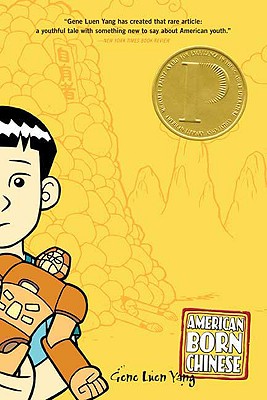 No response yet, but I appreciate that he’s been open to the discussion with the commenters on his blog, and I hope he’ll read some of the excellent books they have recommended, including one of my own favorites, Gene Yang’s American Born Chinese—a rather brilliant and deeply moving graphic novel about a Chinese-American boy struggling with identity and acceptance. I think this teacher’s negative feelings about comics are quite common among adults, especially those who sincerely wish to cultivate in students a love for reading and a nuanced engagement with literature. Comics may strike these adults as fluff, twaddle, mental junk food. In my experience, this negative stance nearly always means the adult hasn’t read many comics—or is possibly repeating disparaging things said by adults in his life when he was a kid immersed in the exploits of Metamorpho and Adam Strange, so enchanted by story and pictures that he didn’t notice he was acquiring an impressive vocabulary and a sophisticated grasp of story structure, character development, and setting.
No response yet, but I appreciate that he’s been open to the discussion with the commenters on his blog, and I hope he’ll read some of the excellent books they have recommended, including one of my own favorites, Gene Yang’s American Born Chinese—a rather brilliant and deeply moving graphic novel about a Chinese-American boy struggling with identity and acceptance. I think this teacher’s negative feelings about comics are quite common among adults, especially those who sincerely wish to cultivate in students a love for reading and a nuanced engagement with literature. Comics may strike these adults as fluff, twaddle, mental junk food. In my experience, this negative stance nearly always means the adult hasn’t read many comics—or is possibly repeating disparaging things said by adults in his life when he was a kid immersed in the exploits of Metamorpho and Adam Strange, so enchanted by story and pictures that he didn’t notice he was acquiring an impressive vocabulary and a sophisticated grasp of story structure, character development, and setting.
Amusing side note: today’s mail brought a review copy of The Manga Guide to the Universe by No Starch Press. Jane has learned a ton about electricity, relativity, and statistics from previous Manga Guides. I would be so much smarter if I read more comics…
Related: Comics in the Library: SDCC panel recap
One of the best panels I attended at SDCC was Comics in the Library, moderated by Gina Gagliano of First Second Books, featuring four librarians from different parts of the country:
• Candice Mack, LA Public Library
• Mike Pawuk, Cuyahoga County Public Library (Ohio)
• Eva Volin, Alameda Library (CA) [Twitter]
• Gene Anbaum, Unshelved [Twitter]
This is a writeup of my panel notes. I was writing quickly, so it’s possible I’ve made mistakes below—my apologies if so!
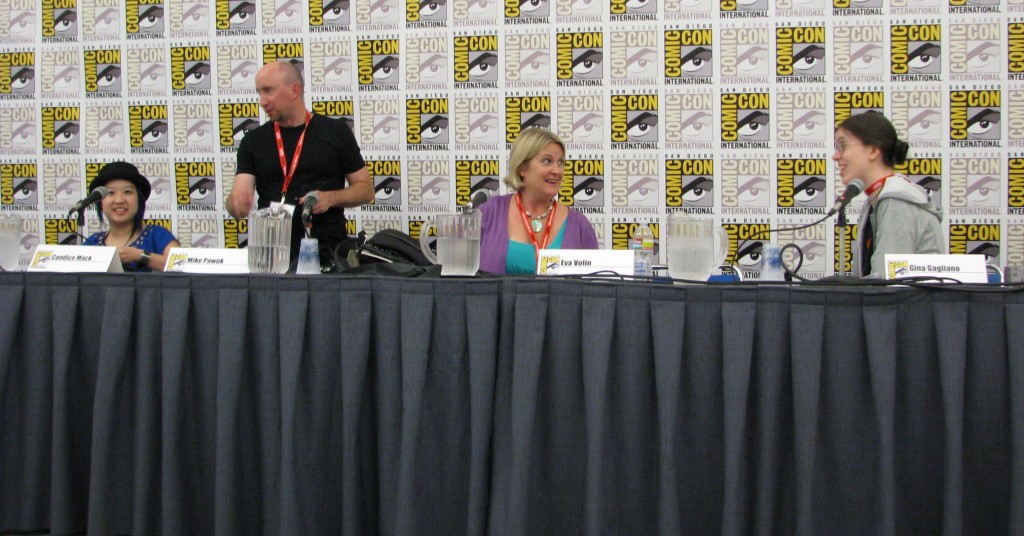
From left: Candice Mack, Mike Pawuk, Eva Volin, Gina Gagliano. Sorry I didn’t get Gene Anbaum in the photo!
(more…)
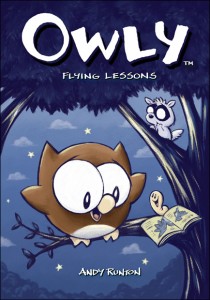 Again, quickly typing up my notes. These are things that piqued my interest and beg a closer look, when time permits.
Again, quickly typing up my notes. These are things that piqued my interest and beg a closer look, when time permits.
No particular order here except the order in which I encountered them at the con. (UPDATE: this post got too long! So now it’s a Part One.)
• Owly (kids’ graphic novels, the one I saw was wordless and sweet, published by Top Shelf Press)
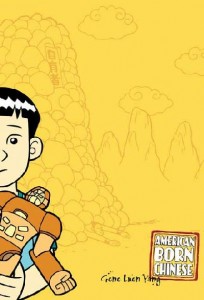 • Practically everything at the First Second (:01) booth made me drool—I was already familiar with these folks, having read (and been blown away by) Gene Luen Yang’s American Born Chinese a little while ago. Gene was on one of the children’s graphic novel panels I attended at SDCC last year.
• Practically everything at the First Second (:01) booth made me drool—I was already familiar with these folks, having read (and been blown away by) Gene Luen Yang’s American Born Chinese a little while ago. Gene was on one of the children’s graphic novel panels I attended at SDCC last year.
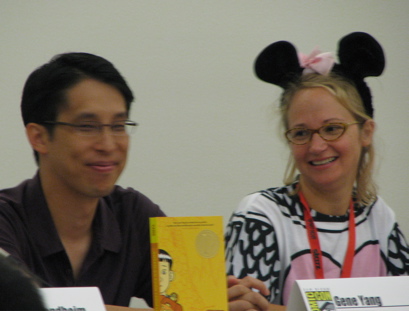 Gene Luen Yang and Jennifer Holm at SDCC 2009.
Gene Luen Yang and Jennifer Holm at SDCC 2009.
This year, “Urgent Request” from The Eternal Smile (written by Gene; illustrated by Derek Kirk Kim) won the Eisner for best short story, which is very exciting. To my amusement, at the very moment I was paging through Eternal Smile, I looked up and there was Gene with his family at the First Second booth. He and his wife had their three small children in tow—Gene was wearing the baby in a front-carrier, a heartwarming sight. We chatted briefly; it was a delight to meet them.
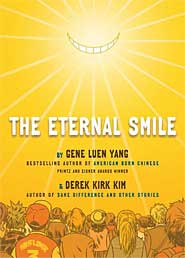
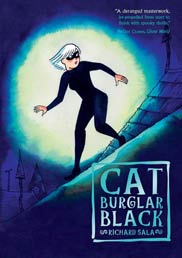
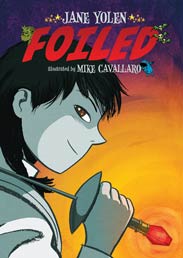
• Back to First Second Books. Other titles that caught my eye:
—Cat Burglar Black
—Adventures in Cartooning—we’ve checked this out from the library, big hit with my kids, but I don’t think I’ve mentioned it here before
—Foiled (Jane Yolen)—has been on my TBR list, even more appealing in person, wonderful art
—Tiny Tyrant
—The Color of Water
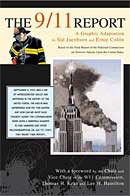
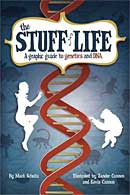

• Hill & Wang, an imprint of Macmillan. Boy was I impressed with these folks! They’re publishing nonfiction graphic novels on a somewhat stunning range of topics. Author Jonathan Hennessy gave me a copy of The United States Constitution—that’s right, it’s the Constitution in graphic novel form—and when I brought it home to Jane, she devoured it the next day. She’s raving about it; I’ll write more when I’ve had a chance to review it myself.
Other intriguing Hill & Wang titles:
—The Cartoon Guide to Economics. I went back to the booth on Sunday to buy this—I usually save my purchases for the last day so I don’t have to lug stuff around for too long—and dadgummit, it was sold out. But it’s on my list of must-haves for Jane. And I hear there’s a Cartoon Guide to Statistics on the way…
—The 9/11 Report. Scott bought a copy of this. He’s excited.
—The Stuff of Life, “a graphic guide to genetics and DNA” with art by one of my favorite Comic-Con pals, Zander Cannon. There’s a sequel on evolution forthcoming soon.
—Biographies of Isadora Duncan, Malcolm X, Ronald Reagan, J. Edgar Hoover, Che Guevara. We came home with the Duncan bio; Jane enjoyed it; more on that one later too.
—Anne Frank: The Authorized Graphic Biography. Arresting art. I’m eager to take a closer look at this one.
—The Beats, a graphic history of the beat poets with text by Harvey Pekar.

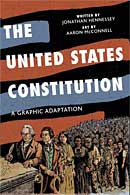
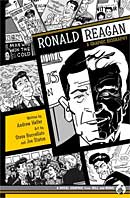
OK, that’s a lot for one post. More to come in a follow-up.
More on SDCC 2010:
A few photos
Photos of supercool steampunk wheelchair
Awesome sketch drawn for me by the incredible Fiona Staples
What I did at SDCC
Rick Riordan panel
LOST Encyclopedia Panel
Epic fantasy panel
Books that caught my eye (part 2)
















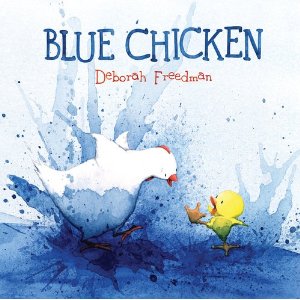

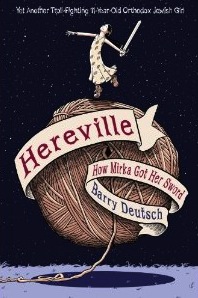
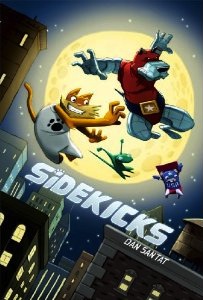
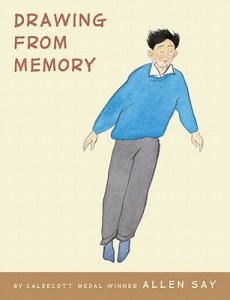




 Gene Luen Yang and Jennifer Holm at SDCC 2009.
Gene Luen Yang and Jennifer Holm at SDCC 2009.







